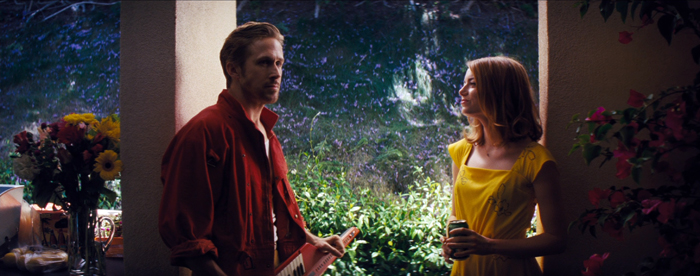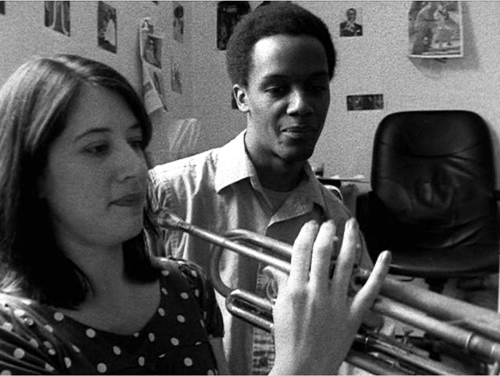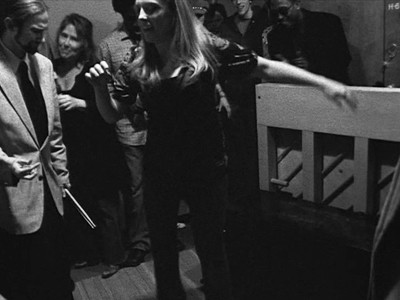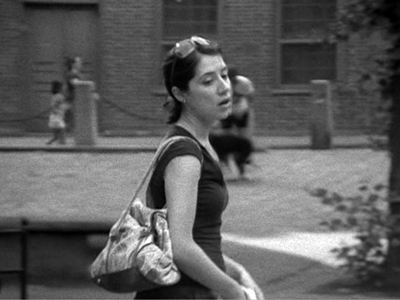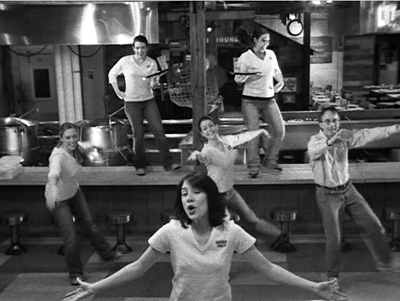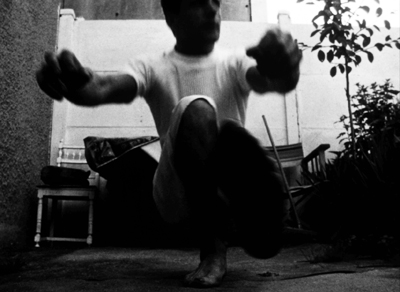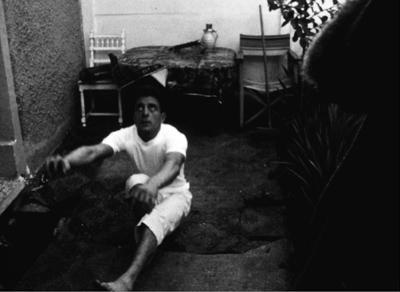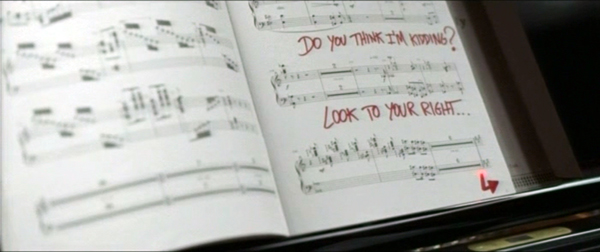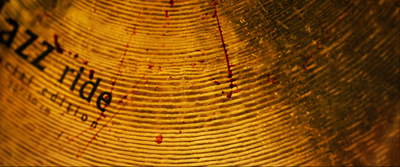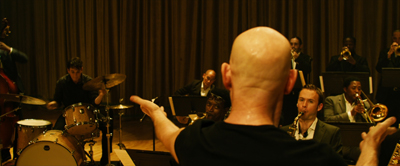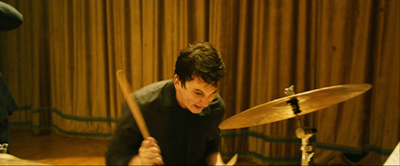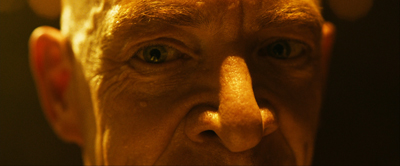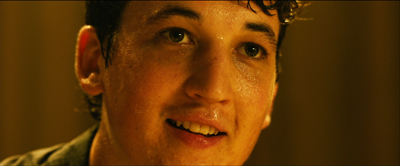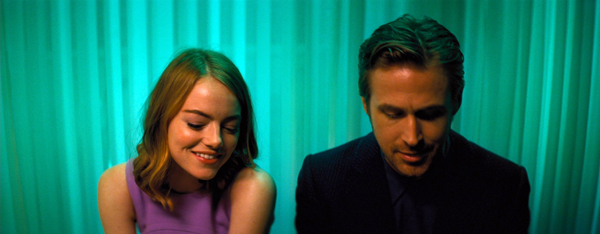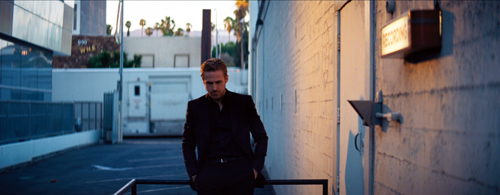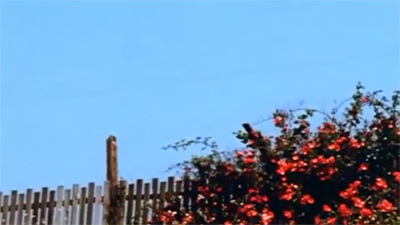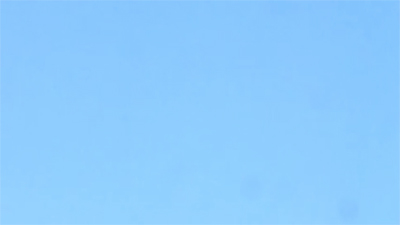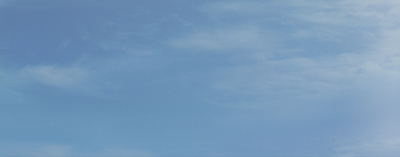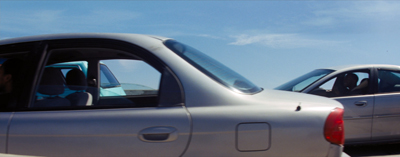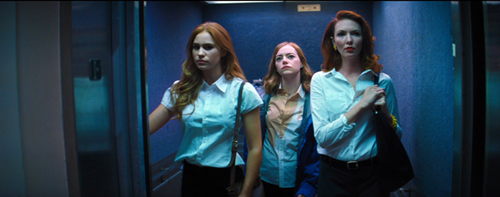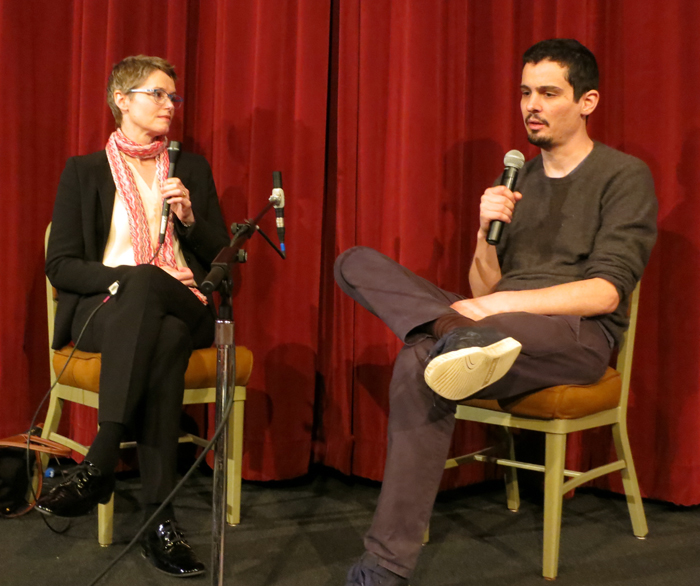New colors to sing: Damien Chazelle on films and filmmaking
Tuesday | March 6, 2018 open printable version
open printable version
La La Land.
DB here:
Between the end of principal photography on First Man and the start of post-production, Damien Chazelle squeezed in a visit to the UW–Madison. We’re very glad he did. A hell of a time was had by all.
His visit culminated a Cinematheque series devoted to his work. On Friday 23 February we picked him up at O’H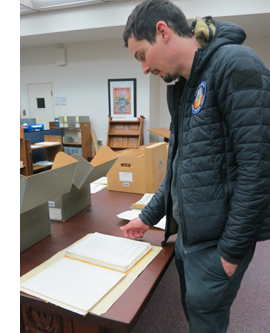 are and had a fine ride back talking about film and less important things. Then he visited our archives at the Wisconsin Center for Film and Theater Research; on the right, he examines an original Final Revised script of Citizen Kane.
are and had a fine ride back talking about film and less important things. Then he visited our archives at the Wisconsin Center for Film and Theater Research; on the right, he examines an original Final Revised script of Citizen Kane.
After that, he sat down for a conversation about his career with a hundred or so students. At a quick dinner, he and our Cinematheque impresario Jim Healy gave dueling impersonations of Michael Gazzo as Frankie Pentangeli. Damien then plunged into a long Q & A with a full house who had just seen La La Land in 35mm.
Next morning he met with Criterionistas Kim Hendrickson and Grant Delin for a FilmStruck segment. Then, in a discussion with Kelley Conway, he introduced a string of films he curated for the Cinematheque. But he wasn’t off the hook, because driving back to O’Hare with Kelley and Jeff Smith, he was immersed in more film talk.
Damien proved himself the ultimate guest—friendly and generous, enthusiastic and excited, free of airs and snark. We learned a lot from him. Herewith, a sample.
A Direct-Cinema musical
Guy and Madeline on a Park Bench.
Although he considered a musical career, film was Damien’s first love. He wrote scripts in middle school, transcribed movie dialogue from VHS tapes, and as an undergrad watched films in Harvard’s magnificent archive. The film program there, with leaders like Alfred Guzzetti and Ross McAlwee, stressed documentary and experimental film, and the exposure stuck. Among the films Damien curated for our Cinematheque show were the Rouch-Morin investigation Chronicle of a Summer and Su Friedrich’s Sink or Swim.
No surprise, then, that his first feature, Guy and Madeline on a Park Bench, was shot in a Direct Cinema mode. It’s got light leaks and run-and-gun footage, complete with bumpy handheld pans and zooms. To get around problems of inexperienced actors, Damien told some of them that it was a documentary. The 16mm project was produced over three years; sometimes the exposed films sat in the lab while Damien drummed up donations from friends, family, and strangers. (Writing blind to Harvard alums, Damien got a donation from John Lithgow.) When a processing accident ruined some footage, Damien’s producer talked the lab into free work for a time.
Guy and Madeline cuts among three characters: trumpeter Guy, his ex-girlfriend Madeline, and his new girlfriend Ilena. Like a Nouvelle Vague film, it relies on chance encounters. Madeline is emotionally wrenched by the breakup with Guy, and we follow her efforts to find work and a new partner. Ilena’s semi-reluctant meeting with an older man who brings her home to meet his daughter reminded me of the moment in Shoot the Piano Player when Charlie, running from the thugs, falls into step beside a stranger who tells him his own troubles. And of course the title characters recall the separated lovers of The Umbrellas of Cherbourg.
For all its documentary textures, the film at times becomes what J. Hoberman called a Mumblecore musical. But there’s a gradual shift to the full-blown show-biz mode. Damien talked of the thrilling moment in Hollywood musicals when realistic presentation of a scene gives way to nondiegetic music and the characters leap to a new, more ethereal level. Guy and Madeline presents this transition in gradual doses.
At first, the numbers are motivated realistically. Guy, an African American, plays trumpet with a jazz ensemble, so we get scenes of their performance at a local hangout. We move a bit further toward stylization with a party sequence that induces some talented kids to indulge in singing and tap-dancing among their friends—captured in casually imperfect framings.
The transition to pure musical fantasy comes forward after the breakup in a solo number, with Madeline singing a soliloquy as she wanders in the park. There’s no sense of an audience; this is a private reverie. (A whiff of this tune, heard on a car radio, makes its way into La La Land‘s opening shot.)
When Madeline takes up work at a diner, the components come together in an all-out production number addressed to us.
In an echo of Bande à part’s “Madison” sequence (lucky name), shooting a dance number in cinéma-vérité mode brings out an intriguing friction. It’s the same kind of productive clash we get on the soundtrack, between Justin Hurwitz’s shimmering Legrand-inflected score and varieties of jazz (Dixieland, Guy’s cool composition for Madeline). And like Nouvelle Vague characters, these people are devoted to books, the arts, and self-exploration.
As a “staged documentary” Chazelle’s film parallels Chronicle of a Summer in an intriguing way. That film starts as pure Direct Cinema, with investigators stopping people on the street to ask them questions. But as we get to know the group the film concentrates on, there’s a lot more control and “fictionalization.” There are precise matches on action, for instance, with camera ubiquity indicating careful restaging.
This rigging doesn’t damage the film as a document of summer 1960. Damien learned from it that you can make a truthful movie by “creating a situation with less and less acting to do.” Given this hybrid quality, Chronicle of a Summer becomes a vivid example of a moment when a film mode is “figuring itself out.” Its self-conscious artifice, which includes participants watching themselves during a screening, was foundational for the New Wave. “You watch a language being born.” That language was also political, as Damien pointed out: The film summons up memories of the Holocaust and glimpses of the Algerian war.
In other respects, Damien’s first film looks forward to La La Land thematically and formally. Guy and Madeline starts with the moment of the couple’s breakup (on the bench) and flashes back to vignettes of their love affair before returning to the bench. This opening loop is like the one that jumps from Mia’s night out back to the traffic jam and then follows Sebastian. A large stretch of each film’s plot is about how the couple’s lives converge and diverge.
Similarly, when the signature tune “I Left My Heart in Cincinnati” is played, shots of Madeline and Guy frame a flashback to the combo’s earlier performance, as if they’re sharing the memory. Something similar happens at the climax of La La Land, in what seems to be a mutual vision of Sebastian and Mia’s alternative future. As often happens in Chazelle’s cinema, epiphanies burst out in moments of musical performance.
Blood, sweat, and tears on the drumhead
Grand Piano.
Despite playing many festivals and winning critical praise, Guy and Madeline didn’t open any doors in Hollywood. Damien picked up odd jobs, not all film-related, while writing commercial genre screenplays. He sold a kidnapping script (not made) and Grand Piano (2013), skillfully directed by Eugenio Mira. He began getting assignments like The Last Exorcism Part II (2013) and he contributed to the screenplay for what became 10 Cloverfield Lane (2017), released long after he’d worked on it.
I found Grand Piano pretty impressive on the big screen. Chazelle’s script and Mira’s direction create a solid thriller built around the situation Hitchcock designed for his versions of The Man Who Knew Too Much. Most of the action takes place during a concert celebrating the return of a traumatized pianist to the stage. As he’s about to start the program, a sniper uses cellphone messages and scribbles on the score to demand a perfect performance of the florid piece that spooked the pianist years before.
At first restricted to the pianist, the film’s viewpoint widens gradually to include others, and soon crosscutting builds tension. The tormenting voice (“Play one wrong note and you die”) calls to mind the music teacher in Whiplash. As in a classic thriller, the climax arrives when the victim must fight back. And as in Whiplash, the performer wins using the only weapon he has: nearly crazed virtuosity.
Damien now thinks that the long germination of the scripts for Whiplash and La La Land made them better. As financing kept falling through, the films gained more layers. Whiplash (2014) found a home first, with Blumhouse producing and helping with the financing. It was their idea to shoot a scene to show investors (we screened it in our series), and the project found financing at Bold Films.
Given a $3 million budget and a 20-day schedule, Whiplash demanded meticulous storyboarding and very little coverage. Like Hitchcock and Leone, Damien shot only what he needed. He used two cameras for the rehearsal scenes and three for the climactic concert. The cuts and camera moves were planned to coincide with measures of the music.
Damien calls Whiplash a film about music (the same could apply to Grand Piano). It owes a lot to the sports-film genre as well; Damien envisioned its punishing force as indebted to Raging Bull. He turns big-band drumming into blunt-force trauma, with gory drumheads and cymbals. Sam Fuller would have approved.
Like Guy and Madeline and Grand Piano, Whiplash culminates in a musical performance that carries a powerful emotional impact. No wonder that as a kid Chazelle studied one-reel movies of classic drummers, then started to think of the shorts as films in their own right. In this spirit he curated for us two Dudley Murphy shorts, St. Louis Blues (1929, with Bessie Smith) and Black & Tan (1929, with Duke Ellington), along with the 1954 documentary Jazz Dance, a night on the town that explodes with pure human happiness. In all these, music-making is pushed to the edge of ecstasy.
This time around with Whiplash (good name for a movie about sadomasochistic musicians), I noticed its straightforward classical construction. Damien says that he learned screenplay construction after moving to LA. Its tale of a boy caught between a good but weak father and a punishing, strong one gains strength and sharpness from its traditional four-part plot.
At the crucial 25-minute mark, Fletcher wins Andrew’s trust. Four minutes later, in the performance of “Whiplash,” Fletcher is bellowing and Andrew is sobbing. First reversal noted. The second part, the Complicating Action, interweaves Andrew’s romance with Nicole, his persistence in drumming, and his fraught relation with his family. This part culminates at the midpoint with Fletcher’s giving Andrew a new rival, which impels Andrew to break up with Nicole. In the Development section, Andrew suffers more setbacks. A harrowing car accident leads him to botch a major competition and assault Fletcher. He leaves school, accuses Fletcher of abuse, and abandons drumming.
After he discovers Fletcher playing piano in a club, he agrees to join his new combo, which preciptates the climax: a competition performance at which Andrew, realizing that Fletcher is out for revenge, seizes control. The result is another burst of barely controlled frenzy, complete with unmotivated bursts of light spattering Andrew in the last shot.
Whiplash is a film without pity. Andrew’s rejection of Nicole suggests that he’s become obsessive, and after his scuffle with Fletcher he’s drained and numb. And no sympathy is extended to the monstrous Fletcher. Damien avoided what he called the “rubber ducky” moment that shows this man to be damaged by some childhood trauma. We get no explanation of his ruthless brutality; he’s simply a force to be fled or fought. (Damien told us that he modeled Fletcher on a music teacher he’d had; the original probably wasn’t as nasty, but Damien wanted the film to convey how frightening he was to a fifteen-year-old.)
At the end, Andrew earns a glint of triumph, but the reverse shot shrewdly withholds from us the expression that might warm us up to this man. His sliced-off smile and slight nod are all it takes for Andrew to react.
Still, his grudging approval means that Andrew has won over one scary dad.
Embarrassing yourself and your characters
At 29, Chazelle found himself with a hit, confirming the Magic Number 30 Rule. Whiplash made a splash at the Sundance Film Festival and went on to be nominated for several Oscars, winning three. It also brought in a lot more than its cost. Damien could now reignite La La Land.
Lionsgate, via Summit, picked it up and production began. There were 40 days of shooting across 65 locations. The production was able to be so efficient because of careful planning and the reliance on long takes. “The long take has become fashionable,” Damien says, who knows his film history: “But it’s actually the most old-fashioned kind of thing.” Whiplash is an editing-driven movie, but La La Land relies on many fewer shots. The moments of shot/reverse shot–notably in the spoiled dinner when Sebastian is briefly between tour gigs–gain a prominence they don’t have in most movies.
In shooting, the morning was given over to rehearsals, followed by a great many takes–often required to sync the actors to playback. Around about take twelve, Damien recalls, things started to crystallize, but sometimes as many as twenty takes were needed. While Whiplash stayed tight to the screenplay, La La Land was heavily improvised. The visuals were pre-designed, but the relationship at the center needed a casual feel, as if the characters were tossing off their lines.
Damien had thought he would simply be able to cut together the “one-ers,” but editing took five months, not least because he and his long-time editor Tom Cross played with many versions. Every number was a candidate for deletion, including the freeway opening. (Yeah, I shuddered.) There was also some digital adjustment of the 35mm original. David Koepp wrote me:
Maybe ask Chazelle about how beautifully he used color to direct our eye in his LA LA LAND opening. Always the right burst of costume color directing us to the right spot at the right time… although I guess that’s more of a compliment than a question.
Damien explained that he made those colors pop a bit more by digitally toning down other costumes in that intricate opening sequence.
La La Land has steadily grown in my regard and affection; I think it’s one of the best recent American movies. Just the title gets you going. “La la” suggests music, but also the self-absorption of jamming your ears lalalala. LA is a town of airheads, but it can become a town of worthwhile fantasy too. Damien spoke of most movies trying to make fake sets look real; he wanted to “take real stuff and make it look false.”
This time around, I was struck by the film’s harsh side. It’s pretty hard on mainstream Hollywood, from the smug partygoer who says he’s really good at world-building to Mia’s superficial roommates. Their anthem “Someone in the Crowd” is about careerism, but it becomes for her about the search for a soulmate.
Then there’s Sebastian. A lot of Hollywood plots work only if the guy is a jerk. In Whiplash, Andrew turns smug when he thinks he’s Fletcher’s pet, and he dumps Nicole heartlessly. (He’s becoming a bit like Fletcher.) In La La Land, I began to see Sebastian as a stubborn nerd, refusing to play the cocktail-bar set list and ranting about jazz to anyone who’ll listen. Ryan Gosling’s ingratiating performance makes this nerd more likable, but as written the character is pretty arrogant.
One scene that puzzled me now makes sense in a larger pattern of Seb’s obtuse, evasive behavior. After he learns he may be kept from attending Mia’s show, why doesn’t he phone her? We see him brooding outside the music studio.
He may think he can still make it in time, which would reflect his somewhat risky self-assurance. But Damien pointed out that elsewhere in the film he’s not seen using a cellphone, or for that matter a computer. Old school as he is, he seems wary of modern technology. He drives an utterly impractical Buick convertible. He plays cassette tapes and LPs and his apartment’s phone is an old-style handset, antenna and all. An omitted screenplay scene showed him in a movie audience ranting at somebody using a phone, thereby disturbing the viewers more than the caller has.
I’m being too hard on Sebastian, of course. We admire his idealism, his tenacity, and his romantic attachment to what he thinks is the best of the past. Still, Damien has remarked that he sees sides of himself in both Andrew and Sebastian, which reminds us that “commercial” films can also be personal ones. For him, the strongest creative choices risk exposing you. “If you’re not embarrassing yourself, you’re not doing your job.”
If Sebastian is too willful, Mia is too eager and desperate. “I can do it differently,” she tells the audition staff after they’ve brushed her off. Sebastian and Mia complement each other. His cockiness (“Fuck ’em”) pushes her to mount her one-woman show, while she tries to steer him back to his basic commitments. The larger theme seems to me that the most vital art comes from yourself, be it your memory of a Francophile aunt or your irrational attachment to classic jazz. Instead of having to fit into prefab TV characters, Mia gets her breakout role in a film that will build its script around her personality.
Damien spoke of the musical as Hollywood’s most avant-garde genre. That partly stems from the transition from realism to fantasy that launches a number. This shift provides the film’s final turning point, with Mia’s audition; for once a Chazelle film makes its musical climax a subdued one, but it’s no less a demonstration of the performer’s authentic emotion. Art’s power comes from novelty (“new colors to sing”) grounded in sincerity and self-awareness, even if by some standards it seems awkward and geekish.
The avant-garde overtones are also a matter of how musicals make real locations look unreal—as Demy films memorably show. So it was uncannily appropriate that Damien asked us to introduce La La Land with Bruce Baillie’s All My Life (1966). A slow pan left across a fence and flowers gives way to a diagonal tilt up to the sky; the whole accompanied by Ella Fitzgerald and Teddy Wilson.
La La Land might well be a sequel, as we tilt down from another blue sky to a gridlocked freeway.
As Baillie turns a prosaic bush and fence into an audiovisual flow, so the opening of Chazelle’s film takes the banality of a traffic jam and makes it an explosion of youthful hope and energy, complete with somersaults.
The sheer cinematic exuberance of La La Land will, I think, keep the film alive for a long time. “Every scene, a new idea”: Damien quoted Arnaud Desplechin quoting Truffaut. Many parts of La La Land put nifty tweaks on the conventions of comedy, drama, and the musical. There’s the “enacted” slow-mo at the party, the iris around a kiss, and the montage rendered as a flash-forward from a duet at the piano (“City of Stars”). There’s often a tweak on what might have been perfunctory filler. The exit-on-an-elevator shot is lit and costumed so as to (a) suggest the conformity of the dress code for an audition; (b) emphasize the height of her rivals; and (c) accentuate the spill on the less glamorous Mia’s blouse. Her disadvantages are diagrammed.
Then there’s the idea of having a “real” dream ballet at the planetarium and a virtual one at the end. Speaking of the end, I especially liked the head-fake at the start of the present-time part. By showing Mia on the Warners lot and Sebastian in his club, we’re invited to infer for a moment that they stayed a couple, before revealing that she’s actually married to an easygoing beefcake and Seb still lives alone.
Pitching La La Land, Damien found that many producers insisted that the couple unite for a happy ending. Damien objected that many of the great romantic films, including Casablanca, A Star Is Born, and Gone with the Wind, center on lost love. Still, he found a way to a happy ending by offering an alternative outcome that many viewers will prefer.
True, it’s sad. But Jacques Demy once remarked that sad movies make him happy. For me, La La Land is that sort of movie.
How much does cinephilia help a director? I’d expected Damien to recommend the sort of movie immersion he had as a kid. And he admitted the power of the past. “I can’t unwatch the movies I’ve seen.” But some great directors aren’t cinephiles, he granted. He cited Bresson and Dreyer; I thought of Ford. What’s important, he suggested, is a relation to some, any art form–if not film, then visual arts or theatre or literature.
Maybe the best of both worlds is to be a young filmmaker who knows both film and another medium, such as music, and thinks as an audiovisual artist. Damnien remarked that in writing he starts with images rather than words but then lets the dialogue focus the scene. Interestingly, Eisenstein taught his students to stage a scene first as if it were in a silent film, then revise it with music, color, and (only then) dialogue. That assured that pictorial storytelling would be foremost.
Kristin and I were gratified to hear that Damien has over the years read several things we’ve written. In turn, he taught us a lot. His visit reminded me that one path to filmmaking achievement is just thinking about your craft and your choices, in light of your life experiences and your encounters with powerful art. He passed that lesson along to the hundreds of people who came to learn from him.
Thanks to Damien Chazelle and Alissa Goldberg for making the visit possible. Thanks as well to J. J. Murphy, Mike King, Ben Reiser, Matt St. John, Mary Huelsbeck, Amy Sloper, Maria Belodubrovskaya, Erik Gunneson, Jason Quist, Kim Hendrickson, and Grant Delin. Event planners Kelley Conway, Jeff Smith, and above all Jim Healy, Cinematheque Director, deserve massive gratitude as well.
We have other discussion of La La Land on this site: my search for some of its roots in 1940s innovations, and my analysis of its song plot. There’s also a wide-ranging conversation among experts Kelley Conway, Eric Dienstfrey, and Amanda McQueen. Jeff Smith weighed in on the film’s score, correctly predicting its Oscar triumph.
P.S. 8 March 2018: Many thanks to Steve Elworth for a correction about All My Life.
Kelley Conway interviews Damien Chazelle.












